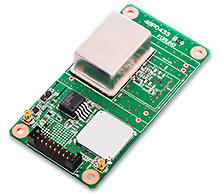Articles for ITS market
Many Firsts! On-Site Report from Tokyo Auto Salon 2022
- The author, who knows what goes on behind the scenes, looks back on 40 years of history. -
Held on site for the first time in two years
Last year's Tokyo Auto Salon was held virtually online due to the COVID19, but for the first time in two years, the in-person event was held in Makuhari Messe, in Chiba Prefecture.
According to the organizers, the first day of the event, January 14was the business day and open to the press. It drew 24,934 visitors, and the total number of visitors for all three days including January 15 and 16, which were open to the public was 126,869.
With the cancellation of the Tokyo Motor Show, scheduled to be held in the fall of 2021, this was one of the largest automobile-related events in recent times held in Japan.
Tokyo Auto Salon is held by a single automotive publisher, and its rating differs greatly from the Tokyo Motor Show, led by the Japan Automobile Manufacturers Association (JAMA), which includes all automakers as members.
However, since the beginning of the 2010s, the number of exhibitors and visitors to large-scale motor shows held in Paris, France; Frankfurt, Germany; Geneva, Switzerland; Detroit and New York, U.S., and other cities around the world have been on a downward trend.
Under these circumstances, the SEMA Show in the U.S. and the Tokyo Auto Salon continue to attract a steady stream of visitors to automotive events, mainly for the aftermarket including customized and tuned cars, and automakers are continuing to exhibit at these events based on their track record.
Changing the course from chaos to embracing the changing times
Looking back over the years, I have been covering motor shows and customized car shows around the world for more than 40 years, and I have seen the changes firsthand.
As for the Tokyo Auto Salon in particular, I am aware of the behind-the-scenes changes that have taken place since its predecessor, the Tokyo Exciting Car Show, was launched in 1983. The various relationships between the organizer, the publisher, and the author led to the event's name change to the Tokyo Auto Salon in 1987.
To be honest, the Tokyo Exciting Car Show and Tokyo Auto Salon in the 1980s were a mess. Cars with drastically lowered ride heights gathered from all over the country, causing the Metropolitan Police Department to become very nervous.
In the 1990s, famous stores and tuning parts manufacturers appeared all over the country for engine and suspension tuning and exterior parts called aero parts. Each company transformed itself into a large-scale showroom that held negotiations with customers at the Tokyo Auto Salon for several million yen per project.
The automakers were watching the Tokyo Auto Salon from a distance, believing that this was a trend for the aftermarket and not a business area in which manufacturers should be directly involved.
This has changed dramatically since the 2000s.
In the background, there is a rapid cooling of the tuning car boom. Exhaust gas regulations and vehicle safety standards were revised, and the number of young people who preferred hard tuning as a trend decreased.
The changing times have also affected automakers. In order to add diversity to new cars, interior and exterior specifications and colors were expanded, and parts manufacturers directly affiliated with the manufacturers expanded their lineups of optional parts for new cars.
Furthermore, from the latter half of the 2000s onward, the presence of sports cars in the new car lineups of Japanese manufacturers became less and less prominent. And the number of motor sports fans declined, prompting manufacturers to use the Tokyo Auto Salon as an event to promote sports cars and motor sports.
Meanwhile, the Tokyo Motor Show has turned into an event that gives a bird's eye view of society as a whole for the new era of electrification, automated driving, Mobility as a Service (MaaS), sports cars, and customized cars have become less prominent.
From the perspective of the average user, it is natural to think that the boisterous Tokyo Auto Salon is more fun than the more serious Tokyo Motor Show.
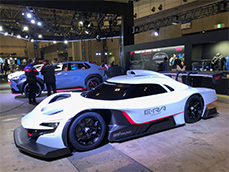 STI (Subaru Technica International)'s "STI E-RA CONCEPT". Photo by the author.
STI (Subaru Technica International)'s "STI E-RA CONCEPT". Photo by the author.
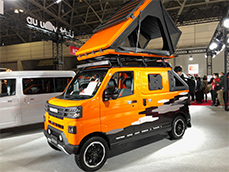 Daihatsu's "Atrai" with various accessories. Photo by the author.
Daihatsu's "Atrai" with various accessories. Photo by the author.
A number of firsts appeared
At the Tokyo Auto Salon 2022, manufacturers exhibited their new sports cars one after another.
The Nissan Fairlady Z was the most conspicuous model. The North American model has already been unveiled locally, but this time the right-hand drive Japanese version was shown for the first time.
The exterior design, reminiscent of the first generation (S30), attracted a great deal of interest from visitors of all ages.
Honda unveiled an almost mass-production ready prototype of the Civic Type R, and Toyota unveiled its limited release GRMN Yaris with even higher performance.
On a slightly unique note, STI (Subaru Technica International), which is in charge of Subaru's special parts development and motor sports activities, unveiled for the first time in the world the "STI E-RA CONCEPT,". An EV four-wheel drive vehicle designed for time attacks on the Nürburgring ring in Germany, known as one of the most difficult courses in the world.
In the same EV category, Mitsubishi Motors unveiled the K-EV Concept X Style, which was jointly developed with Nissan. The exterior is almost identical to the mass-produced eK Cross. It has a battery capacity of 20kWh and a cruising range of about 170km on a full charge. It is planned to go on sale early in FY2022.
As a new area of customization, and in response to the recent boom in camping cars, Daihatsu exhibited a concept model of its commercial vehicle "Atrai" equipped with a roof tent and other external parts, in addition to regular optional parts that can be used for overnight stays.
Among small and medium-sized manufacturers other than automakers, there were notable displays of customized parts for popular mass-produced vehicles with long delivery times for new vehicles, such as the Suzuki Jimny and Toyota Land Cruiser.
As I walked around the venue this time, I had the impression that it was generally quiet.
Although the shift to EVs is not as clear as for mass-produced vehicles, it is clear that the shift to EVs for mass-produced vehicles will have a significant impact on the aftermarket.
Aftermarket-related businesses are probably in the midst of carefully watching the changes worldwide and considering their "next move" in order to survive.
The Tokyo Auto Salon is now facing a new era of change.
Writer introduction

Mr. Kenji Momota Automotive journalist
His major is the world automotive industry and he is also familiar with the energy industry, IT and the aging society problem as the related fields. He acts around the world based in Japan and USA and writes for the general magazines, the technology journals and the automotive related media etc.
He is also commentator of motor race and world's motor show on TV program based on his career of the driver of Indy Racing League and NASCAR. In recent years, he has been covering about a paradigm shift from developed countries to developing countries, the motorized vehicle like EV and the telematics.
FURUNO ITS Journal
Click here for the latest articles after 2022 (in Japanese)2022
- The "realistic" self-driving roadmap shown by the Japanese government and a hands-on report on the latest Subaru EyeSight X
- Will FCVs (Fuel Cell Vehicles) Become Popular? ~New Movement in Toyota and Honda~
- The 'Complete' online sales of new cars start in Japan. Will this new way of buying cars take root?
- Many Firsts! On-Site Report from Tokyo Auto Salon 2022 - The author, who knows what goes on behind the scenes, looks back on 40 years of history. -
2021
- "Moving toward zero traffic fatalities for four-wheeled and two-wheeled vehicles globally in 2050" ~Experience on Honda's latest safety technologies~
- Tsuneishi Shipbuilding's building and DX, an exclusive visit to the main factory
- Japan's Smart City: New Moves toward Practical Use
- When will self-driving buses (service cars) be put to "full-scale" practical use?
- Utilization vehicle data during disasters
- Toyota-led Connected Technology to Transform Commercial Vehicle Business -From light trucks to large trucks and buses-
- Toyota enters the connected car "Personalization" business
- Japanese automakers' carbon-neutral strategies swept up in ESG investment
- Drive experience of the latest autonomous vehicle models and advanced driving support systems
- Will carbon neutrality accelerate the trend to strengthen LCA (Life Cycle Assessment)?
- Semiconductor shortage exposes realities of the automotive industry
- Online Autonomous Driving Contest Enhancing development of Human Resources
2020
- What happens to CASE when gas cars are banned in Japan?
- When will Flying Cars be launched?
- Expectation vs. reality:Autonomous Driving in Japan
- V2X, Becoming increasingly important in autonomous driving
- Technology of Subaru “EyeSight X”
- Lifestyle-oriented French cars gain popularity in Japan
- Human-oriented smart cities are wanted
- MaaS and CASE, how would automotive industry change after COVID-19?
- The beginning of virtualization era, triggered by COVID-19
- Trend of EV shift and consumer demands
- TOYOTA Press conference about ADAS - Releasing algorithm for "sudden acceleration suppression during attempted sudden acceleration" free of charge -
- The Japanese automotive industry in 2020 - 3 turning points -
- "Using a smartphone while driving" and "Level 3 automated driving"
2019
- Motor show business model is at a turning point - Tokyo Motor Show Report -
- Commercialization and monetization of MaaS - ITS World Congress Singapore Report -
- Android Automotive pays attention to V2X - Report from the Frankfurt Motor Show 2019 in Germany -
- Automobile Distribution Revolution and DCM (Data Communication Module)
- Connected business potential and newly proposed "eMaaS" by Honda
- 5G services for practical use are multiplying
- Connectivity technologies attracting attention due to frequent traffic accidents
- Shanghai Motor Show report -SUV, EV, Automated car & 5G-
- Drone Business roadmap and updates to Michibiki (Quasi-Zenith Satellite System)
- MaaS (Mobility as a Service) "town development." Full-scale promotion for a national project
- CES organizer states "Data Period in 2020s." Transformation of the Automotive Industry in CES, US "-CES2019 Report-"
- "Return to Origin" directed towards the age of change, automatic operation and connectivity
2018
- New proposal for Private Car Automated Driving Level and other Hot 5G Technology Topics
- Standardized EV charging infrastructure concerns in Europe, US, Japan and China - Kobe EVS 31 field report -
- Touring a pure car carrier and a test drive of the latest hybrid car
- Planning stage products are exhibited at the newly established visualized mobility service "TOYOTA MOBILITY SHOWROOM".
- Potential “Community Car-share” program promoted by local residents
- CES Asia Report 2108
- Companies attempt new Vehicle-to-Infrastructure communications, including traffic volume measurements and vehicle positioning. -ITS Asia Pacific Forum in Fukuoka-
- Geneva show in Switzerland. Flying cars and MaaS (Mobility as a Service) were hot topics.
- EV (Electric Vehicle) proposals by country
- MaaS competition through service mobilization, M & A and technical field collaboration is accelerating. - The CES 2018 Report -
2017
- Big data’s initiative and fight for the automotive industry. Cooperation among companies becomes increasingly important.
- Connected car and road-to-vehicle communication automatic operation
- ETC (Electronic Toll Collection) and ETC2.0. Current situation and projected future
- Rapid development of sharing economy
- Germany is first to recognize level 3 automated driving
- ITS EU 2017 Field Reports -Automatic Operation and the eCall-
- From Infotainment to ITS, the competitive area is spreading in the car big data industry.
- GTC (GPU Technology Conference) Report and the de facto standardization of AI (artificial intelligence)
- Renesas' new challenge! "e-AI Solution" and "Renesas Autonomy"
- The Automobile industry is shifting from a manufacturing industry to a service industry.
- The movement toward accident countermeasures for aging drivers in Japan
- Fusion of ride sharing and fully automated driving is advancing in the USA.
2016
- Overview of the Quasi-Zenith Satellite System (QZSS) and advancements toward full-scale practical use including the Tokyo Olympic Games - G-space EXPO 2016 report-
- Japan’s automated driving project "SIP-adus" will be a large demonstration experiment.
- The International Home Care & Rehabilitation Exhibition. There were many car manufactures with exhibits booths at this show.
- Japanese car manufacturers starting to concentrate on strengthening the ADAS system
- A new movement of legislation for autonomous cars
- Cyber Security and “AGL”, the new OS for automotive are hot topics in the connected car industry
- “High precision 3D map” the key future of autonomous car and pedestrian dead reckoning
- Chinese “BAT” is accelerating their business in the EV (Electric Vehicle) market
- Tesla's original connection to Taiwan and the new transportation system technologies.
- "The main topic" of the Geneva Motor Show was how to strengthen "pedestrian protection"
- The probe data business is getting more competitive
- Reporting directly from the 2016 CES show "Data services will soon become the main revenue source of automotive industry"
2015
- Do the automated driving systems need the GNSS (Global Navigation Satellite System) ?
- ETC Version 2.0 is coming soon. A new service was announced at the Tokyo Motor Show and the possibility that is could be used as a device for older drivers.
- "Connected Horizon" and "eHorizon". Germany's leading parts supplier accelerates strengthening of "Big Data" for business



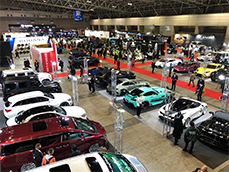 A view of the Tokyo Auto Salon venue. Photo by the author.
A view of the Tokyo Auto Salon venue. Photo by the author.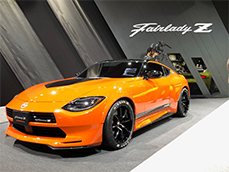 Nissan's new Fairlady Z. Photo by the author.
Nissan's new Fairlady Z. Photo by the author.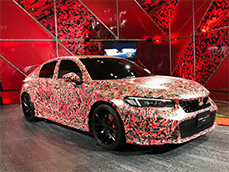 Honda's Civic Type R Prototype. Photo by the author.
Honda's Civic Type R Prototype. Photo by the author.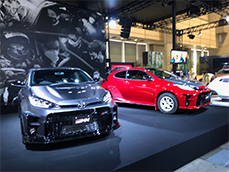 Toyota's GRMN Yaris. Photo by the author.
Toyota's GRMN Yaris. Photo by the author.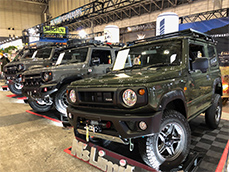 A view of the exhibition by aftermarket manufacturers related to the Suzuki Jimny. Photo by the author.
A view of the exhibition by aftermarket manufacturers related to the Suzuki Jimny. Photo by the author. GPS/GNSS Receiver&Chips and Modules (positioning and timing)
GPS/GNSS Receiver&Chips and Modules (positioning and timing)